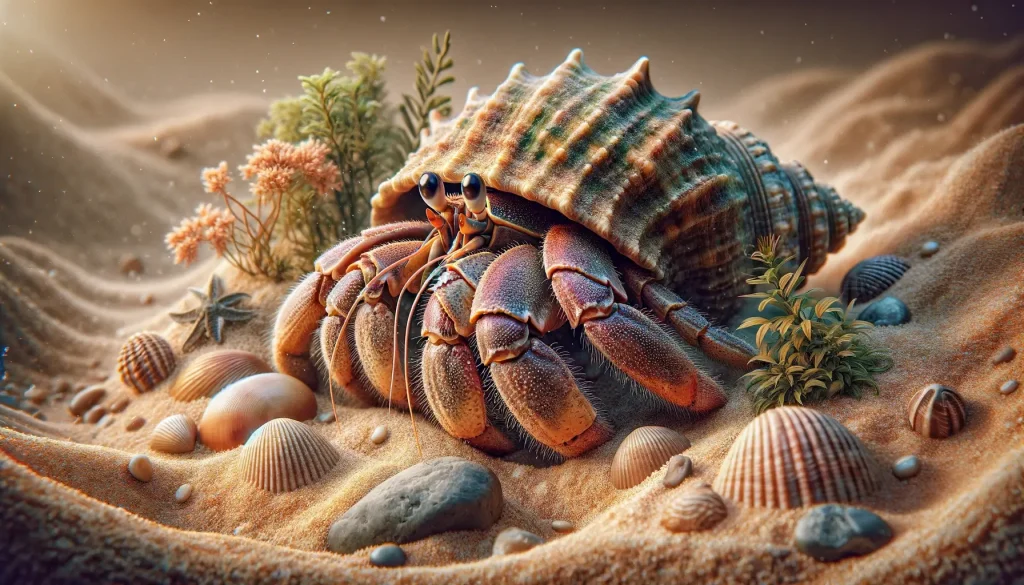
Pet Crab Care
Crabs make fascinating pets, but their care can be intricate. From setting up the perfect habitat to ensuring proper nutrition, pet crab care requires attention to detail. Whether you’re a seasoned pet owner or a first-timer, understanding the basics is crucial. In this guide, we’re focusing on hermit crabs, appealing pets for both children and adults due to their unique behavior and minimal space requirements. A well-maintained crab habitat can be a captivating addition to any room.
To kickstart your crab care journey, you’ll need specific supplies. These not only ensure your pet’s health but also provide an enriching environment. Here’s a quick glance at the must-haves for starting a crab habitat:
- Glass tank: Choose the largest you can afford. Remember, it doesn’t need to be new or water-holding. Look for second-hand options in newspapers or online marketplaces.
- Secure lid: Hermit crabs are escape artists. Use a mesh lid with a solid barrier to retain humidity. For the ultimate escape-proof setup, add weights or locks.
- Substrate: A mix of play sand and coco fiber makes an ideal substrate. Aim for a depth of 6-12 inches or three times your largest crab’s height.
- Heat source: An Ultratherm heat pad is recommended. Position it on the back wall to create a temperature gradient.
- Light source: Natural room light is sufficient, avoiding direct sunlight. Maintain a 12/12 hour light-dark cycle.
- Water conditioner: Use Prime Aquarium Water Conditioner to treat water. This makes it safe for your crabs.
- Ocean Salt Mix: Crucial for creating saltwater pools. Remember, not all salts are the same. Use a brand like Instant Ocean.
- Bowls: Opt for inexpensive food storage bowls. Ensure they are deep enough for your largest crab to submerge fully.
- Gauges: Digital hygrometers and thermometers are more reliable than analog. These help monitor the habitat’s conditions accurately.
Adhering to these guidelines not only helps in setting up an ideal environment but also in nurturing a healthy, thriving pet crab. Let’s dive deeper into each of these areas to ensure your crab care knowledge is comprehensive and effective.

Do Hermit Crabs Have Fur?
When discussing pet care, some pet owners wonder about specific characteristics of their pets, like whether hermit crabs have fur. The simple answer is no. Hermit crabs are crustaceans, meaning their bodies are encased in a hard exoskeleton. This exoskeleton provides protection and support but does not include fur. Hermit crabs are more closely related to lobsters and shrimp, neither of which have fur. Instead, their bodies may have tiny hairs, known as setae, which help them sense their environment. These are not fur in the traditional sense that mammals have but are sensory tools for the crabs.
Understanding the physical makeup of hermit crabs can help pet owners provide better care for these fascinating creatures. It emphasizes the need for a habitat that mimics the crab’s natural environment, including the provision of various shells for their choosing as they grow and need to change shells.
In a way, the shell becomes the crab’s “outerwear,” and ensuring a variety of shells in your pet’s habitat contributes to their wellbeing. Remember, their survival and comfort are heavily dependent on the conditions you create in their enclosure.
Beginner Guide to Raising Quail at Home
What are the Signs of a Dog Concussion?
What Causes Your Dog’s Ears to Smell Bad?
When your dog’s ears start to emit an unpleasant odor, it might leave you puzzled…
Methimazole Treatment for Cat Hyperthyroidism
Methimazole plays a crucial role in managing feline hyperthyroidism, a condition marked by an overactive…
Got Hummingbirds in your Backyard? Here’s How to Care for Them.
Why Does Your Cat Pee Outside the Litter Box?
Cat’s Litter Box Issues It’s not uncommon for cat owners to face the frustrating dilemma…




